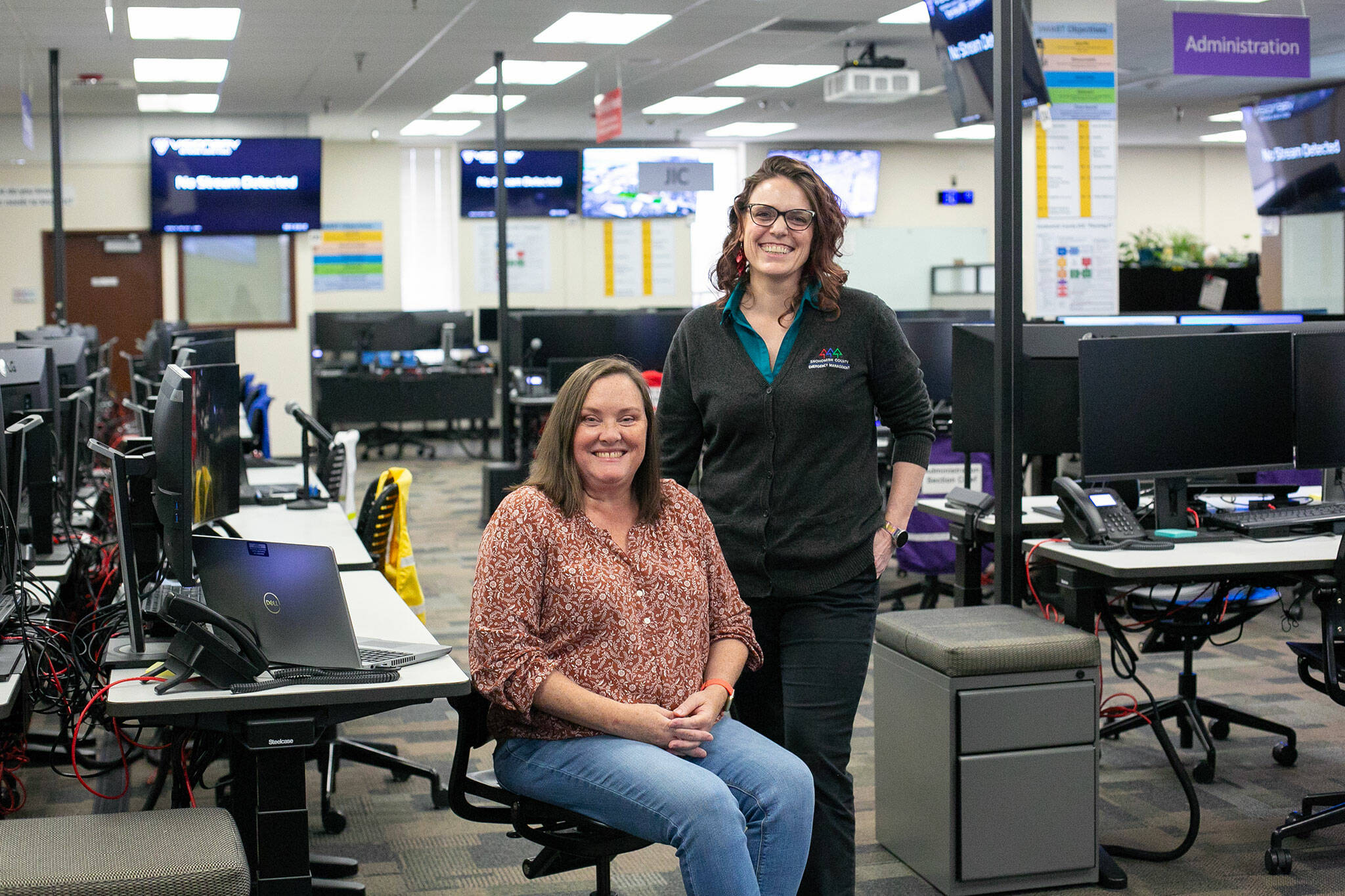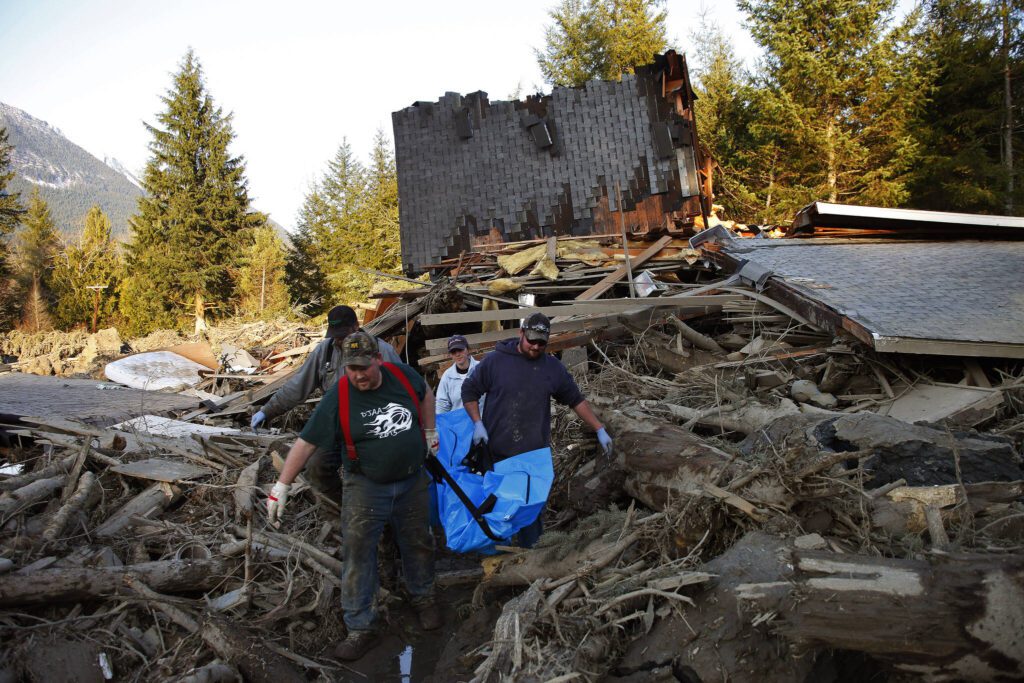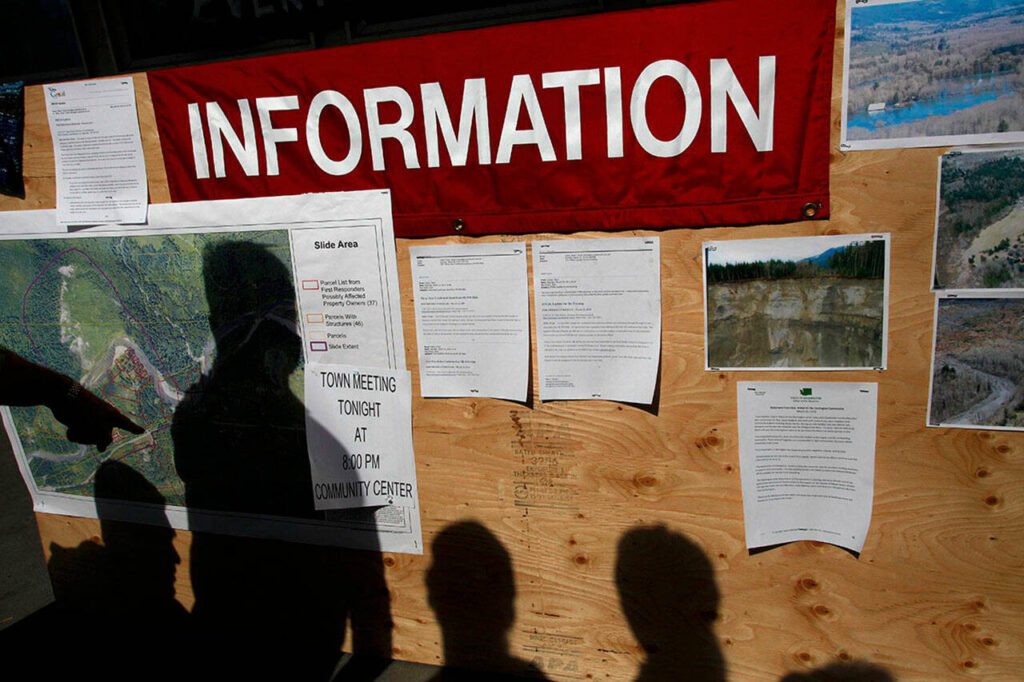EVERETT — In the first days after the Oso landslide, Dara Salmon came in every morning to open the doors of the Emergency Operations Center in south Everett.
A swarm of first responders — police, fire, social workers — would soon join her to coordinate with those on the ground nearly 40 miles away.
As days turned into weeks, Salmon, the program manager at the time, remembers seeing the obituaries trickle in.
“That was really hard because I spent all my time here,” Salmon said in an interview last month at the county Department of Emergency Management. “I heard about what was going on, I knew what was happening. But to see whole families listed in the paper, I couldn’t imagine the grief and the loss the community was feeling.”
Salmon now works as the deputy director of the emergency management department. In her 24-year career, the 2014 Oso slide was the deadliest disaster she witnessed.
The devastation made her consider leaving the profession. But she held onto hope.
“I couldn’t help but think that we’ll come out of this, and be able to take what we’ve learned and do better the next time,” Salmon said. “And I just wanted to be a part of that.”
Ten years later, first responders learned countless lessons from the slide, an unprecedented disaster that claimed 43 lives in a minute. Today, department director Lucia Schmit sees Snohomish County at “the front of the pack” in training and technological advances to deal with future disasters.
“A response never goes perfectly,” Schmit said. “Our professions are one of continual learning. After every incident, one of the biggest factors is taking a look at what happened while it’s all fresh in our minds.”
Lessons from Oso have helped the county to better respond to floods, wildfires, the opioid crisis and the pandemic.
“Oso changed emergency management in the region on virtually every level,” said Scott North, spokesperson for the county emergency management department.
‘There was nothing’
It began as a day off for Sheri Ireton, then a spokesperson for the Snohomish County Sheriff’s Office. She was in north Everett buying science fair supplies with her family.
Then she saw a text on her work phone. There was a landslide up near Highway 530.
“That didn’t mean much at the time because landslides around here happen all the time,” Ireton said. “But the thing that I thought was very strange, was usually when you get an alert like that, you get a couple more messages about how it’s being resolved or who’s getting more information. And there was nothing.”
When she got home, she drove up to the first Incident Command Center in Arlington City Hall.
At the disaster site, meanwhile, survivors dug out neighbors buried in the mud. Helicopters searched from above.
Using infrared cameras, pilots were out looking for survivors until the sun went down, said SnoHawk10 pilot Bill Quistorf, who works for the Snohomish County Sheriff’s Office. From above, they could see no sign of life, except for the searchers.
“There was nothing left,” Quistorf said. “There wasn’t any remnants of a house. It was just rock and mud.”
In the first hours, the emergency response system on the ground was overwhelmed. Team members later said the multi-agency effort lacked communication and clarity of leadership — something that frustrated both responders and community members alike.
An event like a hurricane can at least be predicted, Ireton said. The tragedy of Oso came with no warning.
“No one knew this was going to happen,” Ireton said. “You spend more time trying to understand the impact of it, and how to respond to it that you didn’t have.”
Most evaluations following a disaster cite communication or coordination as an issue with the response, Schmit said. And the bigger the disaster, she added, the “bigger those problems become.”
‘Literally cut off’
The Highway 530 slide was really two disasters, said North, who reported on the slide as it happened for The Daily Herald.
Darrington was isolated by the flood of mud — and cut off from cell service.
“There was no way to drive up to Oso, unless you went all the way up into Skagit County and came down from the north,” North said. “They were literally cut off.”
Phone service was restored two days after the slide.
Six years after that two-day blackout, Scott Honaker, communications coordinator for emergency management, came up with an idea.
In 2020, he developed the Mobile Information Technology Response Unit, or MITRU, an 8-foot tall, 1,200-pound trailer with “all of the hardware necessary” to provide internet and cell service to trouble spots. The MITRUs can be airlifted on short notice in wildfires and earthquakes.
“I think if something like this happened again, we would be able to deploy a unit to either side of the slide zone,” Schmit said.
The county used the trailers at vaccination sites at the start of the COVID-19 pandemic, North said, and two years later during the devastating Bolt Creek Fire.
On a more regular basis, police use the trailers for extreme weather, search-and-rescue efforts and remote crime scenes. The department currently houses four MITRUs, including one that is slightly larger and serves as a command post. Each costs a total of $25,000 — with volunteers doing custom work and assembly, helping to slash the price tag.
Darrington isn’t the only community prone to being cut off from civilization.
In preparation for the “Big One,” a mega-earthquake expected to hit the West Coast, geologists pondered how the county would be broken up.
Last year, the emergency management department created an interactive map to show where roads or bridges could “break” in the event of a 9.0 earthquake in the Cascadia Subduction Zone, or a closer quake along the southern Whidbey Island fault.
Snohomish County could face 58 of the so-called “population islands,” some shared with Island, King and Skagit counties. Everett alone would be divided into about a dozen “islands” along with Mukilteo and Edmonds.
The map is just a start.
“That really shows us where those isolated communities are,” Salmon said. “We’re spending efforts in those communities to try to make them more resilient or more able to withstand some of these geological hazards that do have widespread impacts.”
Last year, the department held disaster preparedness courses for civilians 14 and older. Students could learn to develop a family preparedness plan, practice self-rescue and basic search-and-rescue techniques.
Preparing for the next disaster
When activated for Oso in 2014, the Emergency Operations Center’s workstations were set up in rows, much like a classroom, Salmon said. Almost immediately after, emergency management leaders overhauled the room to make response more efficient.
The operations center now looks more like islands — with nine departments having a designated workstation, along with more monitors, refined displays and a beefed up planning section.
The number of people working in the operations center depends on the emergency, North said.
But before you get to work in the EOC, you must go through the training room next door.
When the county activated its emergency operations center for COVID in 2020, responders trained in emergency management were often forced to work remotely, Schmit said. The obstacle forced the department to reinvent how it trained new employees.
“Oso taught us the importance of having the people from all the departments trained, and COVID added on the layer of being prepared to receive the untrained people,” Schmit said.
The county has since invested heavily in Incident Command System training to prepare responders for another unprecedented disaster, Schmit said. Almost 1,500 responders in the county have participated in the past year. Held in person, current courses teach planning skills; threat and hazard identification; and how to use a HAM radio.
Last year, the county hosted nearly 40% of the emergency management training in the state, with about 70 classes focused on emergency management skills, North said.
A ‘pretty impressive’ drone system
Much of this region’s geological history dates back 12,000 years, when glaciers carved out hillsides to create our present-day landslide risk, Schmit said.
Small landslides happen all the time here, Schmit said. But slides as devastating as the disaster near Oso come with no warning.
“The more impactful an event is, the more rarely it occurs,” Schmit said. “We, as humans, have a very hard time understanding geologic timescales.”
Nothing can be done to stop them, Schmit says. But we can increase awareness in high-risk areas.
Today, the county’s new Unmanned Aircraft System program uses thermal and visible-light cameras on drones to study the landscape for slide threats.
“That’s a program they just didn’t have at Oso,” Schmit said. “But we’re heavily invested in it now, just because of the remote nature of many parts of the county. We want to improve the situational awareness.”
The lidar imaging looks beneath vegetation to see where hills have slipped in the past, North said. The images can be stitched together to create digital maps of landslide history in the state.
The 31-by-26-inch DJI Matrice 300 captures high-resolution images from heights a human photographer could not. The department has two smaller drones with the same cameras.
Emergency management currently has three certified drone pilots, with plans to hire more, Schmit said.
When Western Washington was bludgeoned by heavy rain, causing record flooding in December, cloud cover forced some helicopters to turn around, North said. But drones could still livestream high-risk spots back to the Emergency Operations Center.
“In a decade, we have just really, really advanced,” North said. “The first days of Oso were really exacerbated by not being able to get a good read on what’s happening in the helicopters that flew out there.”
The first responders
The initial response to a tragedy isn’t always just firefighters and medics. It’s the community, Schmit said.
Neighbors along Highway 530 worked with first responders during the rescue and cleanup after the landslide — something often frowned upon in emergencies. But “when you have 27 loggers with the equipment and experience standing there, you don’t tell them no,” Ireton said.
In rotating shifts, they helped cut the wood, operate the machines and dig through the mud — all while grieving those lost.
“There used to be a mindset in emergency management that spontaneous volunteers were a thing that you needed to stop, because they just created chaos,” Schmit said. “Since then, we have realized that they are a thing that will happen. We can’t and do not want to stop people from trying to save their loved ones.”
Cheri Russum, of Providence Regional Medical Center Everett, was sent to Oso the second week after the slide. She served as a family liaison for a week before rotating out. At least twice a day, families gathered in a school gym. Russum stood in front with experts to answer questions.
People, in tears, asked where their loved ones were. Russum herself lost Providence coworkers in the slide.
“There was so much emotion in that room every time we came,” Russum said last month. “We had so much compassion for them and for what they were going through. Can you imagine losing four of your children and your husband, and then not having her home to go to even grieve?”
In March 2020, emergency management officials called for community volunteers one more time.
“What we learned during Oso kind of shifted into COVID,” Schmit said. “When we were trying to incorporate volunteers, take all comers that wanted to be helpful.”
During the pandemic lockdown, volunteers helped at vaccination sites, shelters and schools. Schmit called the call for volunteers, a concept rooted in Oso, a success.
Schmit, who has led the county’s emergency management department since late 2022, can see the effect of Oso as the 10th anniversary of the slide is commemorated this month.
Schmit said: “It is still very much a fresh memory.”
Correction: A previous version of this story misstated when Lucia Schmit took over as director of the county’s Department of Emergency Management.
Maya Tizon: 425-339-3434; maya.tizon@heraldnet.com; Twitter: @mayatizon.
Talk to us
> Give us your news tips.
> Send us a letter to the editor.
> More Herald contact information.






























